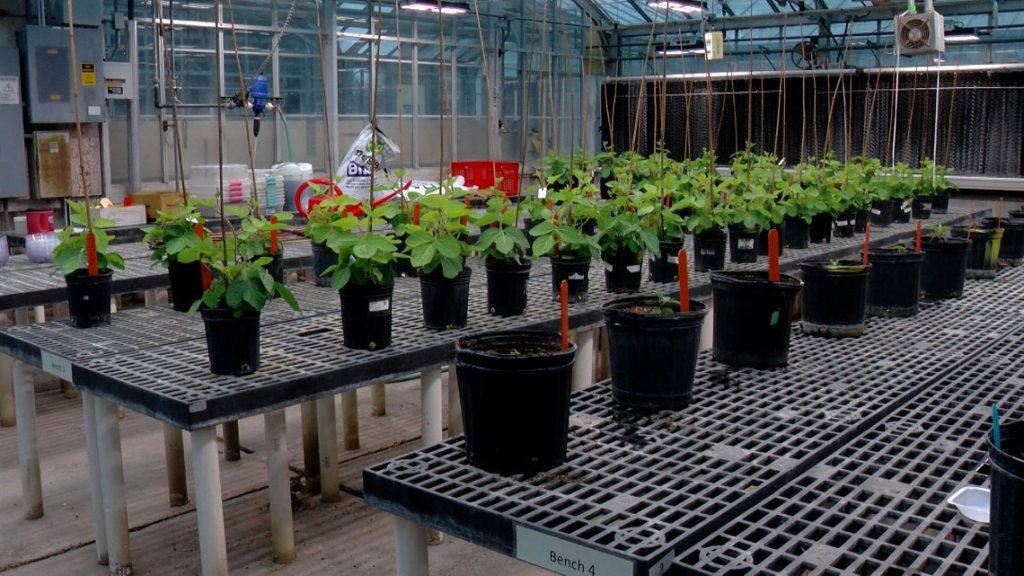
By Bridgette Fox
Capitol News Illinois
[email protected]
SPRINGFIELD – The impending closure of a University of Illinois soybean research lab due to federal funding cuts could impede the study of a fungal disease that experts say would decimate the crop if it makes its way into the country.
The federal government has designated 63 biological agents and toxins, including Ebola virus and anthrax, as having “the potential to pose a severe threat to both human and animal health, to plant health, or to animal and plant products.” Of those, six are plant related, one being Coniothyrium glycines, the fungus that causes red leaf blotch.
Red leaf blotch affects soybeans and can cause 50% to 75% crop yield loss, but is currently only active on the African continent, according to an expert.
The Soybean Innovation Lab at the University of Illinois Urbana-Champaign campus does not test the virus at its laboratory. But it does oversee a network of laboratories across the globe that works to advance soybean development, including by helping study red leaf blotch.
The network includes a team of more than 100 technical soybean experts from across 24 countries, and it does work in 44 countries. The U.S. Department of Agriculture uses the lab’s network to test for disease resistance.
The Soybean Innovation Lab is funded by the foreign aid program at the U.S. Agency for International Development, more commonly known as USAID, and is also tasked with cultivating African countries’ soybean market. But one of President Donald Trump’s first actions after his Jan. 20 inauguration was to sign an executive order halting U.S. foreign aid, all but dismantling USAID.
As for red leaf blotch, Steven Clough, a research scientist with USDA Agricultural Research Service, said pathogens spread around the globe all the time. So, he said, it’s in everyone’s best interest to combat the disease, even if the pathogen is still only in Africa.
“That’s the whole idea – is this would be proactive because we don’t know when the disease comes, if it ever does come, but there’s a good possibility that it does,” Clough said in an interview.
USDA researchers can’t test which soybean plant variants are resistant to the disease except in controlled environments or in a place where the disease is already active. The Soybean Innovation Lab had a presence or partnership in 31 African countries, allowing it to be on the forefront of research.
Clough said a graduate student from Jimma University in Ethiopia was able to work with innovation labs across Africa, planting soybean variants and testing what was resistant. Clough said USDA has between 16,000 and 18,000 variants of soybeans to test for red leaf blotch resistance – but researchers have only gotten through about 1,000.
Now without the Soybean Innovation Lab, the testing is limited to what can be done in a shared, controlled USDA greenhouse at Fort Detrick in Maryland.
“That greenhouse is shared by everybody else who works with other plants and other diseases, so there’s very little space,” Clough said. “So, you can’t screen thousands of different types of soybeans.”
Illinois is also the top soybean producer in the country.
“It’s just a threat that, if it (red leaf blotch) gets here, if we don’t have resistance and growers lose 50% of their yield, that that can be a problem,” Clough said.
But the innovation lab network goes well beyond studying just one disease. Peter Goldsmith, the UI-based director of the Soybean Innovation Lab, said in a LinkedIn post 19 innovation labs at universities across 17 states will be closed.
“U.S. soybean farmers lose one of their best tools to expand their markets and U.S. standards globally,” Goldsmith said in the post. “Local economies in emerging markets lose soybean as an incomparable engine growing wealth, prosperity, and economic development. International security is a loser, as local populations now fall back into poverty, unrest, and migration, due to greater food insecurity.”
He said in an interview the lab was given no warning.
“We had no indication it was coming. We were working hard, meetings were going on, research was underway,” Goldsmith said. “We were very active in January coming off the Christmas break, so it was a 100% shock.”
The Soybean Innovation Lab will remain open until mid-April while UIUC allows its employees – about 30 in total – to find new work.
Goldsmith said he’s holding out hope the lab gets its USAID funding back before its April closure date. But even then, the lab would have to try to rehire employees who’ve already left.
Gov. JB Pritzker said places like the Soybean Innovation Lab “help strengthen food economies and stabilize migration.”
“Removing the ability of public institutions to carry out this work would diminish both our national competitiveness in scientific discovery and our ability to cultivate the next generation of scientists,” Pritzker said in a news release.
Capitol News Illinois is a nonprofit, nonpartisan news service that distributes state government coverage to hundreds of news outlets statewide. It is funded primarily by the Illinois Press Foundation and the Robert R. McCormick Foundation.






